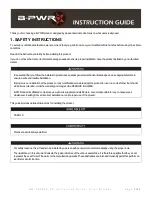
January 2014 - TD 302 Operating Manual for Pressure 4117/4117R Tide 5217/5217R, Wave & Tide 5218/5218RPage 19
CHAPTER 2
Measurement Principles and Parameters
The Pressure Sensor 4117/4117R, Tide Sensor 5217/5217R and Wave and Tide Sensor 5218/5218R measure raw
data of Pressure and Temperature. The pressure measurement is based on a piezoresistive bridge. This bridge
consists of 4 resistors implemented on a silicon diaphragm. One side of the diaphragm is exposed to the water
pressure, while the other is facing a zero atmosphere vacuum chamber. When the diaphragm is flexed by the
hydrostatic pressure the resistance of the resistors will change. By applying a constant voltage over the bridge, a
voltage that varies with the pressure is generated. This voltage is sampled by a high resolution analog to digital
converter (ADC) controlled by a digital signal processor (DSP). A thermistor sensing the water temperature is
also sampled by this ADC. Engineering data are calculated by software in the sensor (Sensor Firmware) based on
these raw data and referred to sets of calibration coefficients stored in the sensor.
All pressure transducers have a temperature drift. By calibrating the sensor at different temperatures, this drift
can be determined. The DSP stores the data from the calibration and is thus able to temperature-compensate
sampled pressure data, as well as to convert the data into linearly calibrated data in engineering units.
All calibration coefficients and settings are stored in the DSP flash-memory. These properties can be displayed
and changed using the RS-232 or RS-422 port (see Chapter 7 for how to communicate with the sensor).
The Sensors can be logged directly by a PC (via the RS-232/RS-422 protocol) and by most PLC’s DCP’s i/o devices,
data loggers and systems.
2.1
Sensor Integrated Firmware
The firmware’s main task is to sample raw data, compute calibrated temperature compensated and linearized
pressure, and present the result at the different interfaces.
All calibration coefficients and settings are called sensor properties, and are stored in the DSP flash-memory.
These properties can be displayed and changed using the RS-232/RS-422 port (see Chapter 7 for how to
communicate with the sensor).
















































